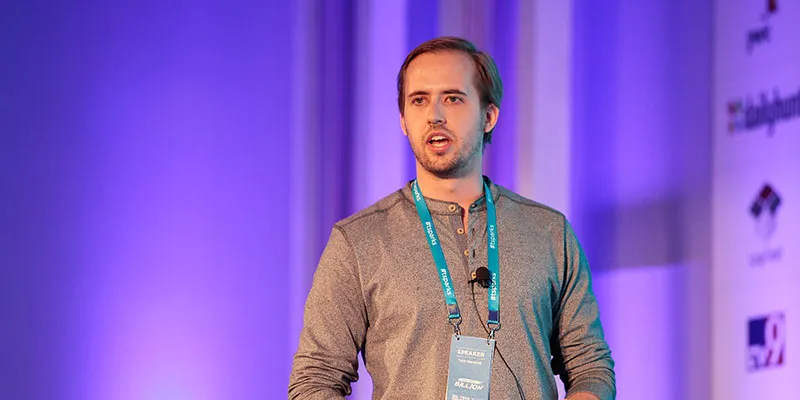Tyler Norwood on the secret to building high performance teams
Your company is not the technology you built. It’s not the top line, or the bottom line. Your company is not the marketing campaign you run or the deck you made to raise money. Your company is your team.
That’s the key message that Tyler Norwood, Global Business Development Manager at the group that owns Jabong.com, had for those attending the last day of TechSparks 2015 on Saturday, 31 October. And Tyler should know a thing or two about the importance of teams – he specializes in building and leading high-performance teams and has spent three years in Vietnam, working for investment firms and technology startups.

Over the course of his journey, Tyler noticed that the most consistent problems in companies, both big and small and across geographies and sectors, always boiled down to the team. Here are highlights from his session about how companies should go about building high-performance teams in today’s tech world.
Step up and be a good leader, but know when to fire people
Founders should have unfaltering belief in their teams and stand by them, according to Tyler. At the same time, they need to be aware of what’s going on and have the guts to fire employees when circumstances demand it. Sometimes, problems arise when employees are hired for the wrong positions and fitment becomes a problem. If they aren’t re-assigned or let go, this lack of action can create serious long-term problems. Tyler added,
Lots of companies that have amazing technology, strategies and marketing campaigns in place (still) fail because they don’t have great teams. There is no way a company can succeed in the long run with a sub-par team. Though it’s obvious, in most cases I don’t see people make hiring right a priority.
He pointed out that most companies have weekly meetings to discuss finance, marketing operations, etc., but don’t give the same importance to regular meetings related to hiring or keeping track of how many CVs are coming into the company, or what sort of employees they are looking to hire. He believes that if the CEO can't step up to the occasion, he or she needs to find and hire a person who can do that and put people in their right place.
Learn how to motivate employees
“If you’re leading your army into battle and you don’t think you are going to win, your soldiers will think the same thing. That applies to the world of business too. So you need to step up as a leader,” Tyler cautioned. To illustrate his point, Tyler narrated the now-famous example of how Elon Musk changed the course of SpaceX’s future with a quick call to action after their third failed attempt to take their rocket into orbit.
“SpaceX only had finances for three rocket launches. The third rocket came close to reaching orbit, but exploded before it could make it. Employees had worked 80-hour weeks for months and were devastated,” he recounted.
Elon Musk promised his employees that they were either going to be successful or go bankrupt. And in that moment of failure, he told all his employees, "What we are doing is rocket science. It is not easy, and I never promised it would be. If you folks are willing to stand by me one more time, I’ll get the capital for more rockets. But I need you all to figure out what went wrong and fix the problem."
It took 48 hours for the SpaceX team to figure out what had gone wrong and they built a new rocket from scratch in six weeks. To put that in perspective, NASA takes roughly three years to build a rocket. Musk’s team launched the rocket into orbit, becoming the first private company to achieve that distinction. And his 10-minute speech is what ensured that his team was motivated enough to fix those problems.
Maintain a big pipeline and be clear about roles and responsibilities
Keep your company in hiring mode 24/7. You never know when someone is going to quit and you need to hire fresh talent to ensure a smooth transition. Tyler added, “Never be the smartest person in the room. Hire smart people who intimidate you.”
“From Day 1, be particular about the roles and responsibilities you assign to employees. Make sure there is a specific job description and employees have clarity of thought. Also break down silos and make teams and individuals share responsibilities and targets,” Tyler added.
I’ve found that making people share KPIs can be very effective in the long term. At the same time, don’t over-structure and over-complicate. Do what’s necessary and do it consistently.
Have face-to-face conversations
“One of the most frustrating things for me is sitting in an office and having the person sitting right next to me send me a Skype or email message. We’re in 2015 and tech is great. But let’s not ‘devolve’. The best way to communicate is still to talk to each other face to face, whenever possible,” he said.
Tyler believes that employees in large and small organizations should talk face to face as much as possible instead of relying heavily on technology. It is easier to pick up on the subtleties of the conversations, which in turn reduces the chance of misunderstanding when there is a human touch.
Tyler is also a firm believer in openly talking about failure. “Encourage failure and don’t hide skeletons in the closet. If you don’t encourage failure, employees will fail and not admit it. And when this happens, everybody fails. It's very difficult to rectify a problem six months down the line, when you finally find it,” he advised.
Another important hallmark of great leaders and teams is that they have no ego clashes and don't impose themselves on other people. “While working with teams, the only thing I can’t accept is ego. Ego kills culture. Founders generally bring their ego in and want the company culture to be their ego. This can be disastrous in the long run,” he warned.
Invest in your most valuable assets – your people
“Many companies consider capital pumped into technology, marketing, etc. to be investments but consider employees on their payroll to be ‘costs’. Treating employees as expendable resources can create a toxic environment,” he cautioned.
The general mentality is to optimise, i.e., reduce costs. But firing people all the time is obviously not good for employee morale. Instead, advised Tyler, it was better to eliminate the need for employees to worry about their well being. Founders need to appreciate their work, motivate them and provide them with challenging problems to work on.
Also make training and development programmes mandatory. This will lead to increased efficiency. So by day 100, one employee will be worth more than three fresh recruits.
Hiring at the bottom and promoting your own employees to the top has produced excellent results in a number of global companies. “A transparent and open hiring structure ensures that employees will stay with the company for long time,” Tyler added.
Tyler signed off with another famous conversation between a CFO and CEO that summarises this situation perfectly:
CFO: What happens if we spend money training our people and they decide to leave?
CEO: What if we don’t and they decide to stay?
Website: GFG







